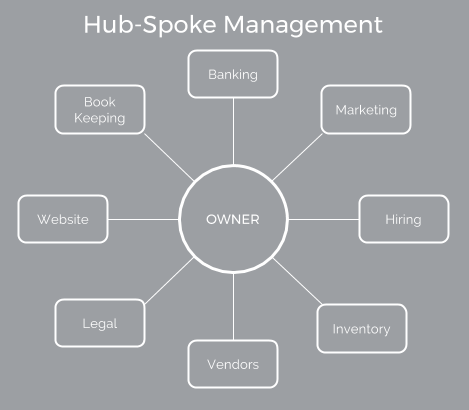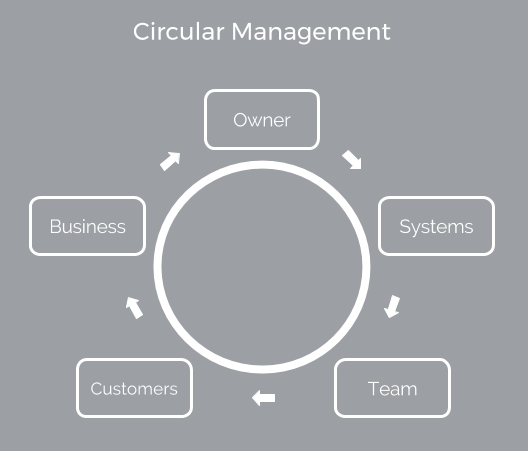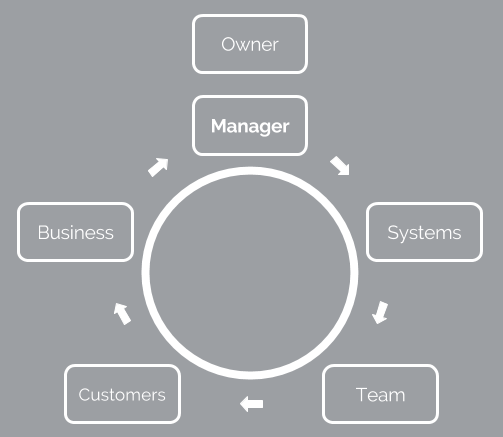7 MIN READ
As a business owner, do you have to go to work?
If you do, you are trading time for money, and that’s the definition of a job. Business owners should earn distribution checks, not paychecks.
A paycheck is compensation for time spent at work.A distribution check is compensation for accepting the risk and responsibilities of ownership.
Distributions are a return on investment, which has nothing to do with going to work.
Some of us are thinking: “Yeah, right. The day I miss work is the day things collapse.” If we’re saddled with that thinking, we are missing out on the greatest opportunity available to business owners – leverage.
Business owners should earn distribution checks, not paychecks.
Leverage means accomplishing more and more with less and less, which ultimately leads to distribution checks and freedom.
Among the most valuable forms of leverage is delegation.
If we, as business owners, insist on doing all the work, or on making or approving every decision, we are forever compelled to go to work, and our earnings are forever limited by our individual capacity to get things done. Delegation removes both constraints.
Most of us know that, so why does the average business owner work 63% more hours each week than the average worker?
Why does the average business owner work 63% more hours each week than the average worker?
One reason is that we don’t know how to transfer our skill and knowledge to a team, therefore we can’t trust them to run the business the way we want it run. It doesn’t have to be that way.
The problem is that many of our businesses are organized like a hub-and-spoke wheel, with the owners at the hub. Customers, vendors, bankers, employees, landlords - everyone who comes in contact with our businesses - are the spokes. All significant decisions run through the hub so the business is always limited by our capacity to get things done. Remove the hub, and, just like a wheel, the organization will collapse.
The circular management style allows us to delegate and take advantage of leverage. In the circular style of management, we use written systems which enable the team to take care of customers, who take care of the business, which takes care of us. When fully developed, the structure enables owners to replace ourselves with managers and to rely on systems and teams to run our businesses – at which point are leveraged and no longer have to go to work every day.



A critical element in the circular management style is written systems. One reason they are not more common is that many of us don’t know how to create them. Fortunately, creating written systems is itself a system and a simple one, once we know the process.
The first step is to create an organizational chart.
“Not interested” you say. “I’ve done it, and it was a frustrating, worthless exercise.”
Hold on a minute, this is not that kind of “org” chart. This org chart is arranged by function, not people.
The are Four Disciplines of Business: Leadership, Customers, Production and Administration.
Arrange your org chart like the one below, or just use this one.

There are many uses for an org chart, but we will use it here to accumulate systems by function and to be sure we don’t miss any.
Functions are independent of the people who do them. We do not create special boxes to match people who do multiple duties. Instead, put those people’s names in multiple boxes.
The next step is to list the things that each function does. No systems yet, not even full sentences. We just make bullet points like those below, or better yet, have our teams list the things they do.
As we go about the day, we should continuously ask ourselves: “Do we have a system for this?” If we don’t, add a bullet point to the list. When we have a comprehensive list of tasks, organized by function, we will already be in the top 5% of all businesses!
Administrative Processes:
Bookkeeping
• Create invoices
• Receive payments
• Make deposits
• Enter bills
• Pay bills
• Bank reconciliation
• etc.
IT Management
• Password procedures
• Back ups
• Internet and email policies
• Software licenses
• etc.
Human Resources
• New hire forms and process
• Exit interviews
• Employee reviews
• Vacation policies
• Compile hours
• etc.
The next step is to begin writing systems. We don’t have to write detailed, fully-developed systems yet. We just choose the most important bullet points – those that will have the biggest impact - and begin to flesh out the written processes, as shown below for invoices.
Administrative Processes:
Bookkeeping
• Create invoices
° Invoice all sales made by 4:00 PM each day
° Create invoice for every sale
° Click “Customer” top bar in Quickbooks
° Select customer name
° Check customer “ship-to” information is correct
° “Date” is date of sale, whether or not entered that day
° Due Date is 30 days from date of sale
° Enter customer PO if provided
° Select items from drop down list
° etc.
• Receive payments
• Make deposits
• Enter bills
• Pay bills
• Bank reconciliation
• etc.
Our fully fleshed-out systems will answer the following questions for the person responsible for doing a task:
Who does the task?
This is answered by the org chart box to which the system is assigned.
When do I do it?
Is this task completed at the beginning of the day, the end of the week, or during down time?
What initiates the process?
Is it a calendar, a sale, or a project assignment? How do I know?
Many processes are routine. For example, they are daily tasks, or are done in response to a customer’s call.
Other projects are assigned when needed. How does the responsible person know when a task has been assigned?
What information do I need in order to do the task this time, if any?
If there is special information, where is it?
Where are materials I need to do the task?
Is a computer or any specific equipment needed to complete the task?
What do I do when I have completed the task?
Is anything recorded or filed when the task is accomplished?
We can’t expect a new hire to be able to execute a system at this point, but we are on our way.
When we are ready to fully develop a system, ask an employee to do the task from our written document. Every time he or she asks for clarification, add the clarification to the written system.
In the example above, an employee might ask, “Where are the customer P.O.s?” or “How do I know what items sold?”
*TIP: Videos are an easy way to record complex processes.
Over time, we will have developed a systemized business running on fully thought-out processes done the way we want them done - and, our businesses will have arrived in the top 1% of all small businesses.
There are many advantages to written systems. Among them:
• A group of written systems is a job description
• A group of written systems is as a training manual.
• Writing systems forces us to think through and optimize the way we do things
• Written systems provide employees with measurable expectations
• Written systems provide objective standards for employee reviews, accountability and incentives.
• Written systems ensure a consistent experience for customers, suppliers and everyone else who comes in contact with the business.
• Written systems provide a means to codify and disseminate best-practices and improvements
• Written systems can double the value of a company
• Written systems transfer our knowledge and skill to our team (even, maybe, with a few improvements)
The greatest advantage of written systems is that they provide leverage. They enable the team to run the business the way we want it run, but without our constant attention, and that is how to transform a paycheck into a distribution check.
Do you have written processes and job descriptions? How are you taking advantage of your leverage as a business owner? Are there any questions you have about org charts, systems, or processes that I didn't answer? Please let me know by leaving comments and questions in the text box below.